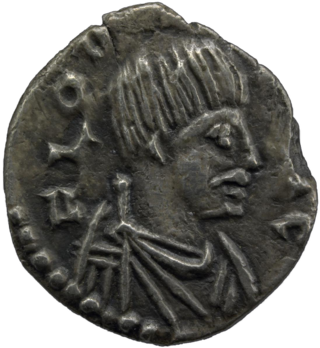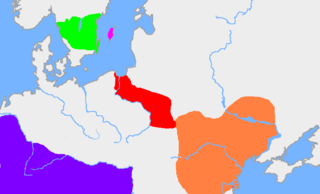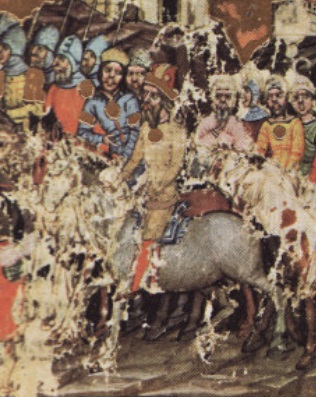Related Research Articles

The Marcomanni were a Germanic people that established a powerful kingdom north of the Danube, somewhere near modern Bohemia, during the peak of power of the nearby Roman Empire. According to Tacitus and Strabo, they were Suebian.

The Ostrogoths were a Roman-era Germanic people. In the 5th century, they followed the Visigoths in creating one of the two great Gothic kingdoms within the Roman Empire, based upon the large Gothic populations who had settled in the Balkans in the 4th century, having crossed the Lower Danube. While the Visigoths had formed under the leadership of Alaric I, the new Ostrogothic political entity which came to rule Italy was formed in the Balkans under the influence of the Amal dynasty, the family of Theodoric the Great.

The Suebi or Suebians were a large group of Germanic peoples originally from the Elbe river region in what is now Germany and the Czech Republic. In the early Roman era they included many peoples with their own names such as the Marcomanni, Quadi, Hermunduri, Semnones, and Lombards. New groupings formed later, such as the Alamanni and Bavarians, and two kingdoms in the Migration Period were simply referred to as Suebian.

Odoacer, also spelled Odovacer or Odovacar, was a barbarian soldier and statesman from the Middle Danube who deposed the Western Roman child emperor Romulus Augustulus and became the ruler of Italy (476–493). Odoacer's overthrow of Romulus Augustulus is traditionally seen as marking the end of the Western Roman Empire.

The Irminones, also referred to as Herminones or Hermiones, were a large group of early Germanic tribes settling in the Elbe watershed and by the first century AD expanding into Bavaria, Swabia, and Bohemia. Notably this included the large sub-group of the Suevi, that itself contained many different tribal groups, but the Irminones also included for example the Chatti.

The Gepids were an East Germanic tribe who lived in the area of modern Romania, Hungary and Serbia, roughly between the Tisza, Sava and Carpathian Mountains. They were said to share the religion and language of the Goths and Vandals.

The Battle of Nedao was a battle fought in Pannonia in 454 CE between the Huns and their former Germanic vassals. Nedao is believed to be a tributary of the Sava River.

The Sciri, or Scirians, were a Germanic people. They are believed to have spoken an East Germanic language. Their name probably means "the pure ones".

Oium was a name for Scythia, or a fertile part of it, roughly in modern Ukraine, where the Goths, under a legendary King Filimer, settled after leaving Gothiscandza, according to the Getica by Jordanes, written around 551.
The Amali – also called Amals, Amalings or Amalungs – were a leading dynasty of the Goths, a Germanic people who confronted the Roman Empire during the decline of the Western Roman Empire. They eventually became the royal house of the Ostrogoths and founded the Ostrogothic Kingdom.
Valamir or Valamer was an Ostrogothic king in the former Roman province of Pannonia from AD 447 until his death. During his reign, he fought alongside the Huns against the Roman Empire and then, after Attila the Hun's death, fought against the Huns to consolidate his independent control over a large group of Goths.

The Turcilingi were an obscure barbarian people, or possibly a clan or dynasty, who appear in historical sources relating to Middle Danubian peoples who were present in Italy during the reign of Romulus Augustulus (475–76). Their only known leader was Odoacer (Odovacar), but he was described as a ruler of several ethnic groups.

Balamber was ostensibly a chieftain of the Huns, mentioned by Jordanes in his Getica. Jordanes simply called him "king of the Huns" and writes the story of Balamber crushing the tribes of the Ostrogoths in the 370s; somewhere between 370 and more probably 376 AD.

Theodoric I was the King of the Visigoths from 418 to 451. Theodoric is famous for his part in stopping Attila at the Battle of the Catalaunian Plains in 451, where he was killed.
Onoulphus, also Onoulf, Unulf and Hunulf was a general of the late fifth century of Scirian origin. He served as magister militum per Illyricum from 477 to 479 as a general of the Eastern Roman Empire, then afterwards was a general for his brother Odoacer, king of Italy, until their death.
Flavius Merobaudes was a Roman army officer of Frankish origin. He was appointed magister peditum around 375, and consul twice in 377 and 383. Ancient sources record that he was put to death that year for his support of the imperial usurper Magnus Maximus, but an inscription records that he became consul a third time in 388.
Mataswintha, also spelled Matasuintha, Matasuentha, Mathesuentha, Matasvintha, or Matasuntha, was a daughter of Eutharic and Amalasuintha. She was a sister of Athalaric, King of the Ostrogoths. Their maternal grandparents were Theodoric the Great and Audofleda.
The Battle of Bolia, was a battle in 469 between the Ostrogoths and a coalition of Germanic tribes in the Roman province of Pannonia. It was fought on the south side of the Danube near its confluence with the river Bolia, in present-day Hungary. The Ostrogoths won, achieving supremacy in Pannonia, but soon migrated south towards richer lands.

The Elbe Germans or Elbe Germanic peoples were Germanic tribes whose settlement area, based on archaeological finds, lay either side of the Elbe estuary on both sides of the river and which extended as far as Bohemia and Moravia, clearly the result of a migration up the Elbe river from the northwest in advance of the main Migration Period until the individual groups ran into the Roman Danube Limes around 200 AD.
Ostrogotho was the daughter of the Ostrogothic king Theodoric the Great, and the wife of the Burgundian king Sigismund.
References
- ↑ Prosopography of the Later Roman Empire. JR Martindale. Volume II, A.D. 395-527, p 574, "Hunimundus 2 leader of the Suavi c. 465". Cambridge University Press, 1980.
- ↑ Reimitz: Hunimund. In: Reallexikon der Germanischen Altertumskunde (RGA). 2. Auflage. Band 15, Walter de Gruyter, Berlin / New York 2000, ISBN 3-11-016649-6, S. 245–246
- ↑ Reimitz: Hunimund. In: Reallexikon der Germanischen Altertumskunde (RGA). 2. Auflage. Band 15, Walter de Gruyter, Berlin / New York 2000, ISBN 3-11-016649-6, S. 245–246.
- ↑ Probably Hunimund, king of the Suevi, whose raid into Dalmatia and hostilities with the Ostrogoths are described by Jordanes, De Rebus Geticis, 53-55. Eduard von Wietersheim, indeed, in his Geschichte der Völkerwanderung (2d ed., Leipsic, 1880-81), ii, p. 324, expresses the belief that the coincidence in name is purely accidental. But if the Hunimund of Eugippius was not Hunimund the Suevian king, who was he? Eugippius through his whole work is perfectly definite in his identification of persons. He names in all some fifty characters, aside from those mentioned in the Bible or in the church fathers. Each is carefully labelled with the appropriate word or phrase, except two, Stilicho (Chapter XXXVI) and Hunimund. It is a fair inference that Eugippius left these names unqualified ----just as, for example, one would now in similar references that of Napoleon or of Blücher ---- because no label seemed needed, either for Stilicho, the great general of the Western Empire, or for Hunimund, king of the Suevi, a principal leader in a war, not yet remote in time, that had devastated Central Europe for years. The life of Saint Severinus. Eugippius. Translated by George W. Robinson, Secretary of the Harvard Graduate School of Arts and Sciences. 1914. Harvard University Press. http://www.tertullian.org/fathers/severinus_02_text.htm#72 accessed 11 April 2020
- ↑ The life of Saint Severinus. Eugippius. Translated by George W. Robinson, Secretary of the Harvard Graduate School of Arts and Sciences. 1914. Harvard University Press. Chapter XXII. http://www.tertullian.org/fathers/severinus_02_text.htm accessed 11 April 2020
- ↑ Prosopography of the Later Roman Empire. JR Martindale. Volume II, A.D. 395-527, p 49, "Alaricus 2 king of the Suavi". Cambridge University Press, 1980.
- ↑ Prosopography of the Later Roman Empire. JR Martindale. Volume II, A.D. 395-527, p 574, "Hunimundus 2 leader of the Suavi c. 465". Cambridge University Press, 1980.